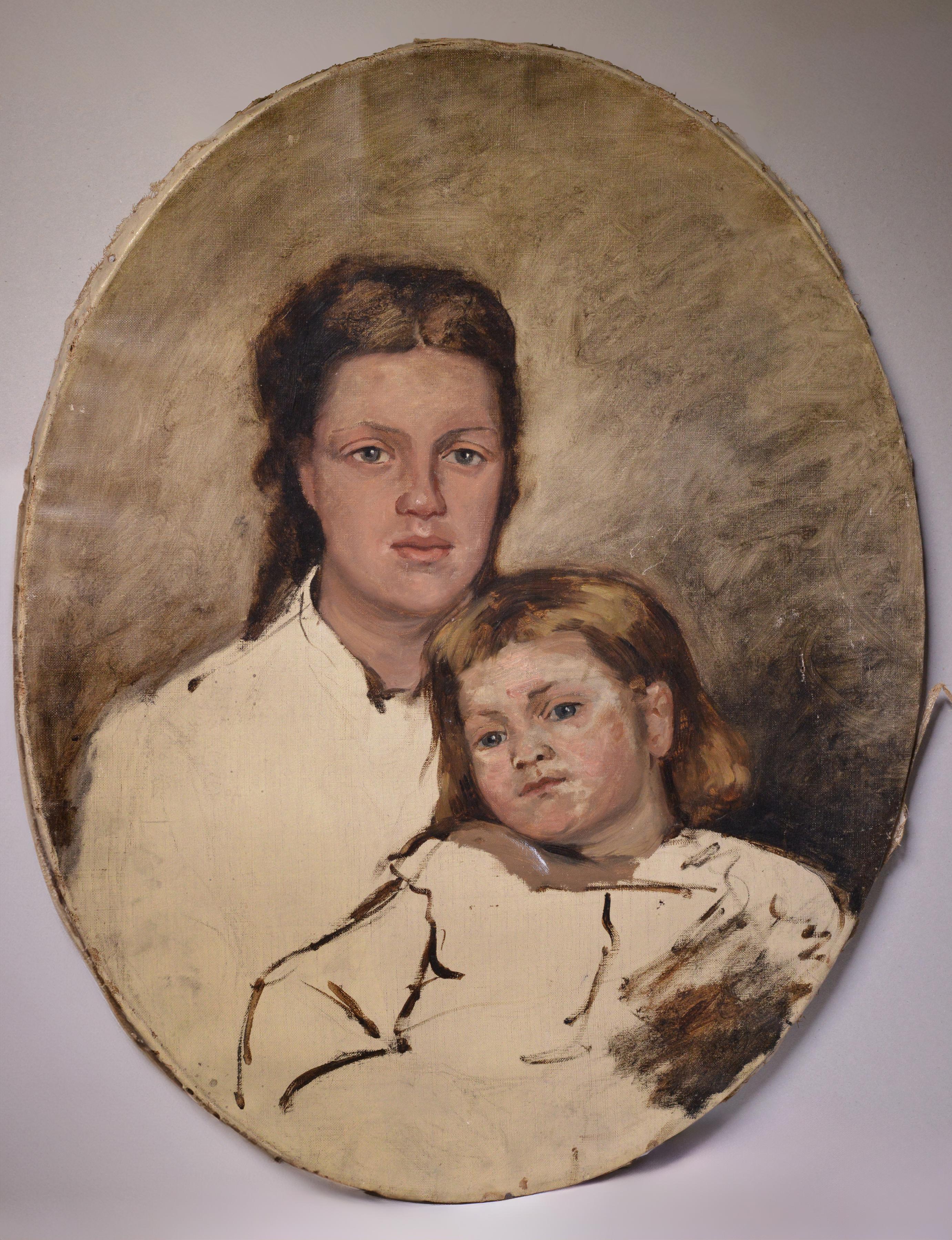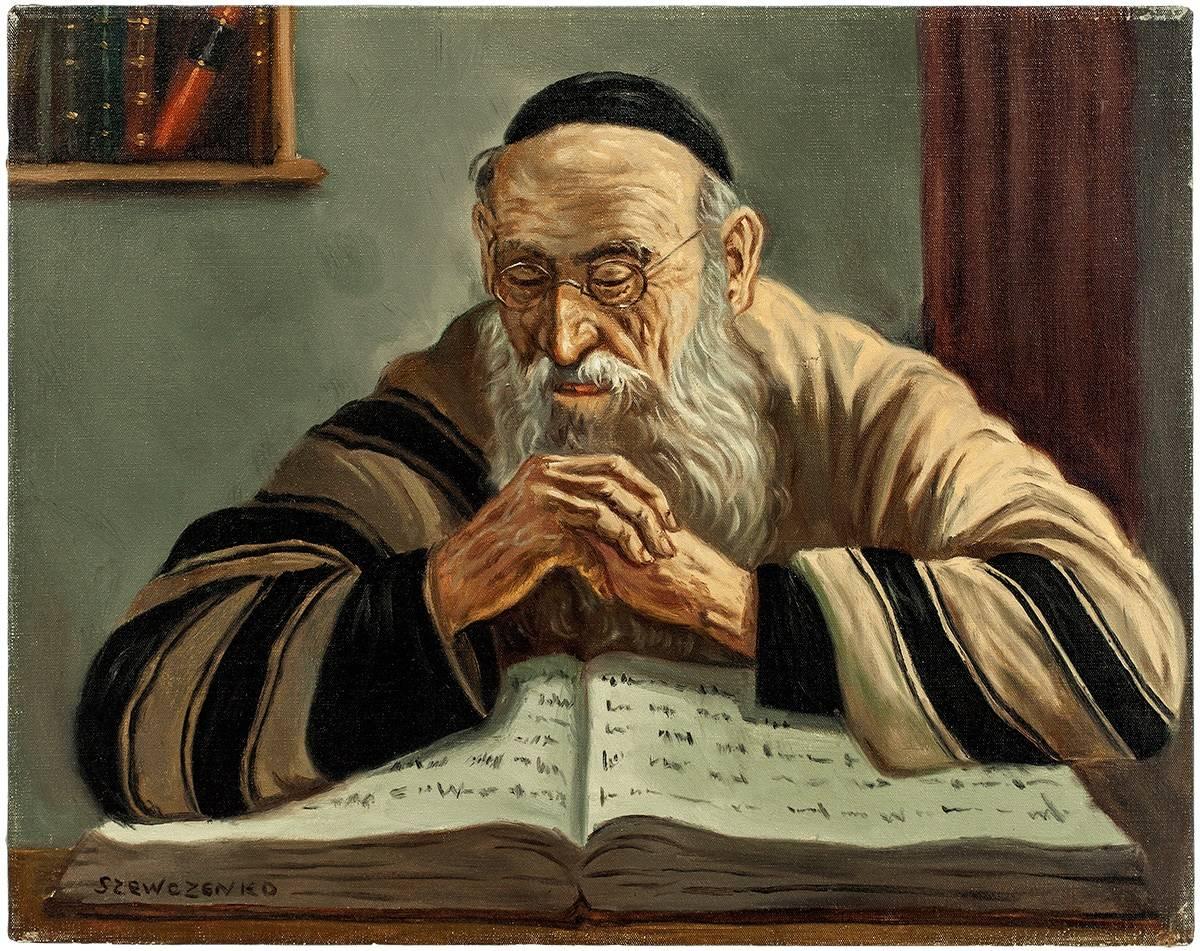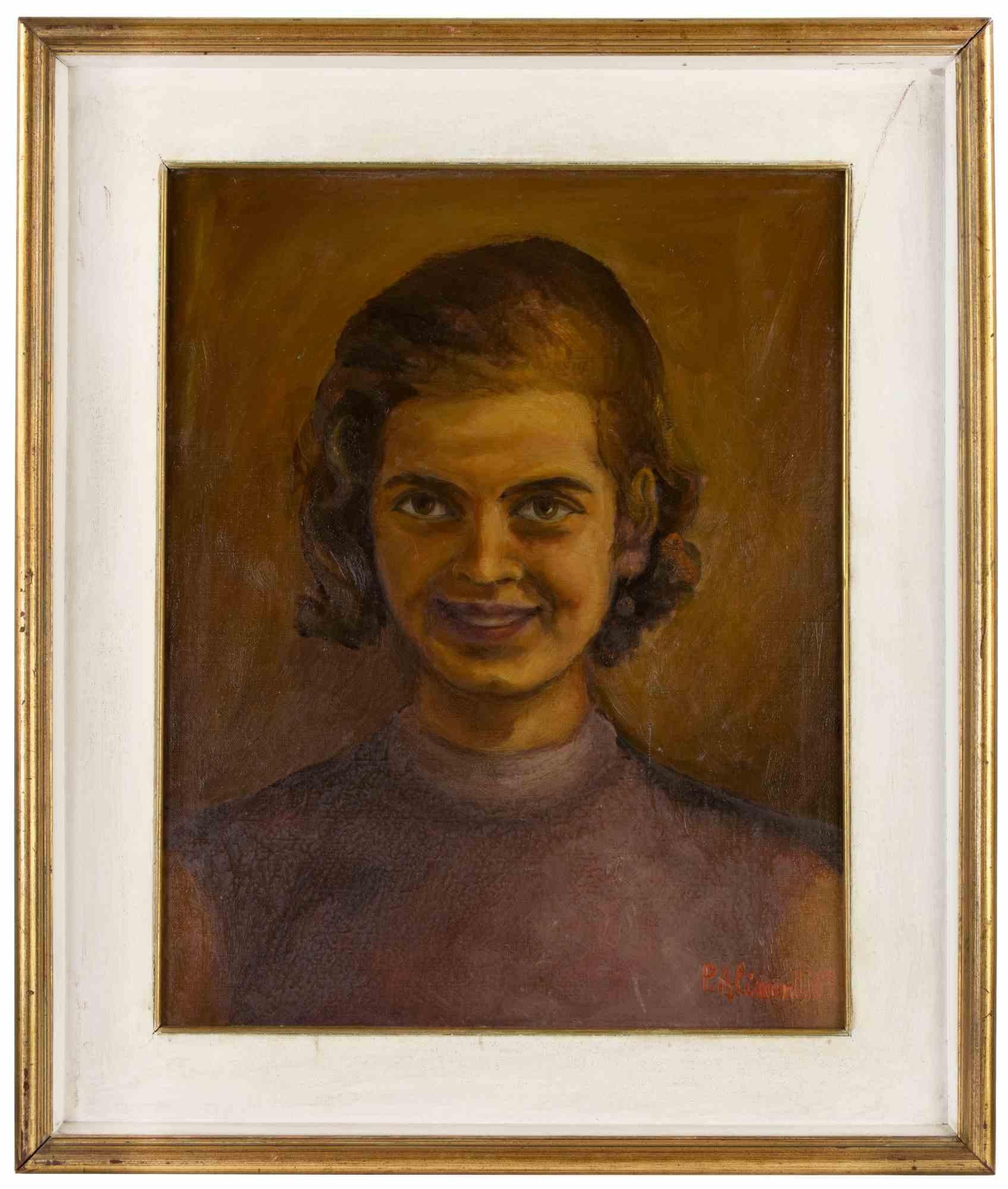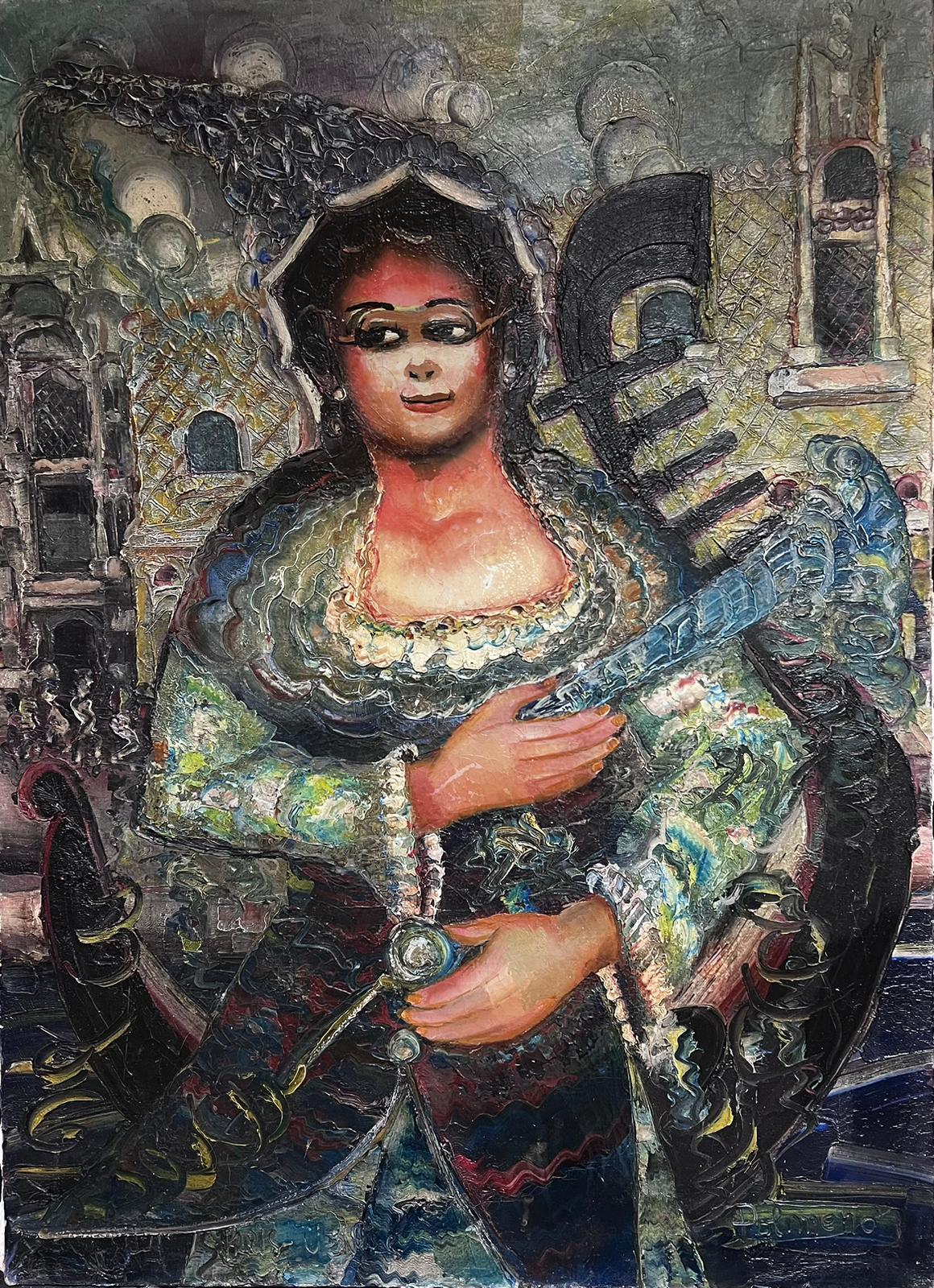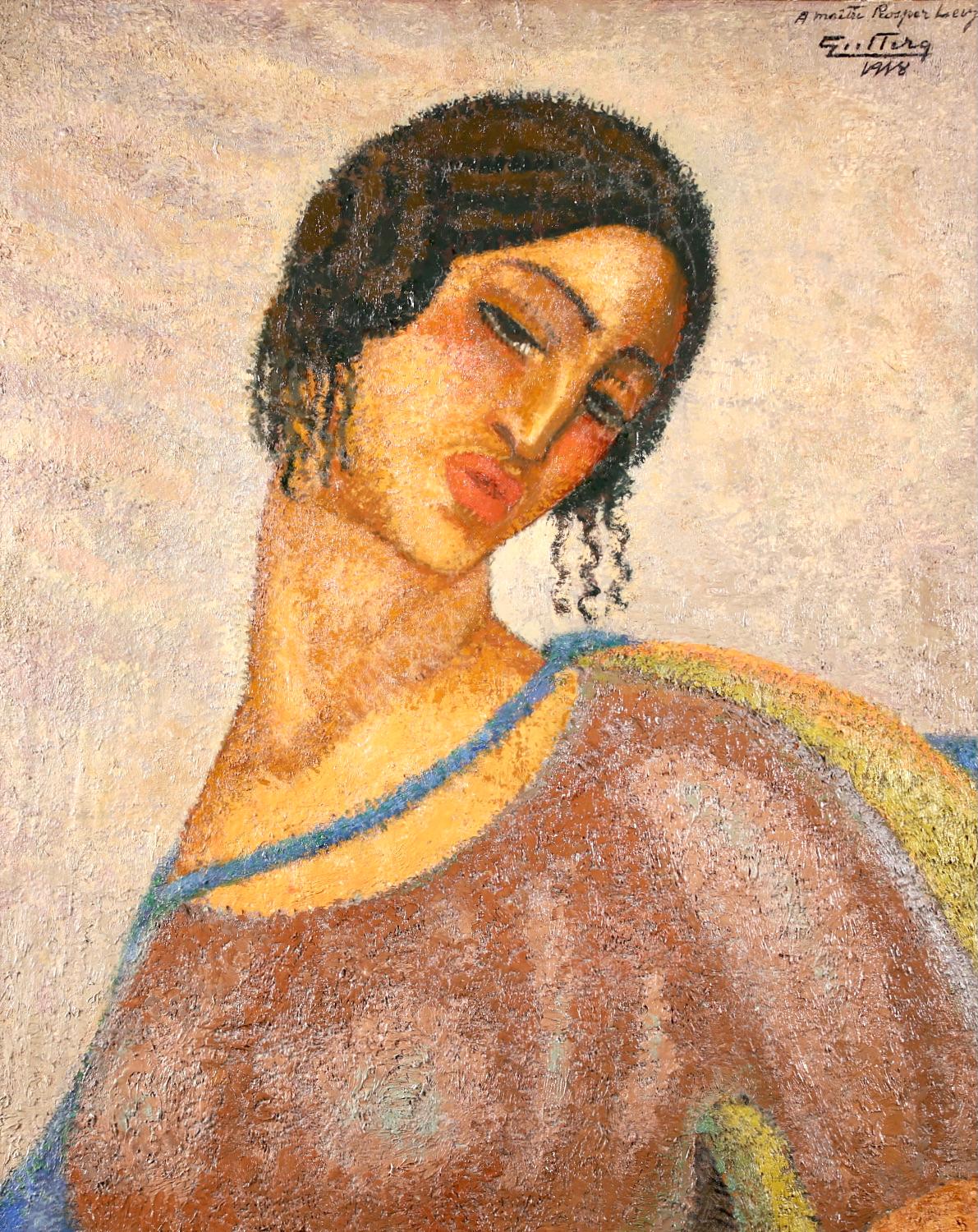Items Similar to 1938 portrait of Marie la Guivinee by Belgian artist Jean van den Eeckhoudt
Want more images or videos?
Request additional images or videos from the seller
1 of 11
Jean van den Eeckhoudt1938 portrait of Marie la Guivinee by Belgian artist Jean van den Eeckhoudt1938
1938
About the Item
A very engaging Post Impressionist portrait painted in 1938 by the Belgian painter Jean Van den Eeckhoudt.
The details of the work are as follows:
Jean Vanden Eeckhoudt (Belgian, 1875 – 1946)
Marie la Guivinee 1938
Oil on canvasboard
Signed with initials ‘J V’ (lower right)
14.1/2 x 10.1/2 in. (36.8 x 26.7 cm.)
£1700
Provenance: from the studio of Jan Vanden Eeckhoudt
Jan Van den Eeckhoudt (known to his friends as ‘Vanden’) was the grandson of the genre painter François Verheyden and nephew of the landscape and portrait painter Isidore Verheyden. It was in his uncle’s studio that, as a youth, he met such artists as Constantin Meunier, Georges Lemmen and Théo van Rysselberghe, who was to become a close friend. Vanden Eeckhoudt’s earliest known work, a still life of crysanthemums, was painted in 1889, when he was just fourteen years old. The following year, on the advice of Meunier, he entered the studio of the painter Ernest Blanc-Garin, where he befriended the young artist Henri Evenepoel. He exhibited his work for the first time in Ghent in 1892, aged seventeen, and the following year had his first solo exhibition at a gallery in Brussels. From 1895 onwards Vanden Eeckhoudt participated in the annual exhibitions of the avant-garde artistic society La Libre Esthétique in Brussels, and in later years also showed at the Salon de Bruxelles and Salon du Cercle Pour l’Art.
In 1904 Vanden Eeckhoudt first visited the South of France, which was to have a profound effect on his art. Until the 1920s he would divide his year between stays in the South of France, mainly in Menton and Roquebrune, in the winter months, and return trips to Brussels in the summer. He came to be known for his richly coloured Mediterranean landscapes, and developed a friendship with Henri Matisse. Vanden Eeckhoudt’s early work in an Impressionist and Post-Impressionist manner was succeeded, around 1913, by a style more indebted to Fauvism, which in turn lasted until about 1920. However, much of his work of these years was lost in 1925 when, suffering from depression, he destroyed around six hundred of his early paintings, and left Brussels to settle permanently in Roquebrune, where he built a villa, named La Couala.
Despite living and working in France for over thirty years, Vanden Eeckhoudt only had one exhibition of his work in Paris, in 1922, and indeed only infrequently exhibited in Brussels. A somewhat morose character, he rarely socialized with other artists or visited exhibitions, and, although fond of music, almost never went to concerts or the theatre. In 1937 he returned to Belgium, having lost the sight in one eye due to cataracts. Although he was beginning to lose his vision in the other eye, he continued to paint portraits and still life subjects into his old age, sometimes exhibiting his work alongside that of his daughter, Julienne (known as ‘Zoum’) Walter, who was a gifted painter and pastellist. Within a few weeks of Vanden Eeckhoudt’s death in 1946, a retrospective exhibition of his work was held at the Galerie Giroux in Brussels.
- Creator:Jean van den Eeckhoudt (1875 - 1946, Belgian)
- Creation Year:1938
- Dimensions:Height: 14.5 in (36.83 cm)Width: 10.5 in (26.67 cm)Depth: 1 in (2.54 cm)
- Medium:
- Movement & Style:
- Period:
- Condition:Oil on canvasboard, paint surface in good order, surface dirt, recently presented in a hand finished art deco stepped frame in silver. Overall good condition.
- Gallery Location:Petworth, GB
- Reference Number:1stDibs: LU540312723082
About the Seller
4.9
Platinum Seller
These expertly vetted sellers are 1stDibs' most experienced sellers and are rated highest by our customers.
Established in 2010
1stDibs seller since 2017
231 sales on 1stDibs
Typical response time: 5 hours
- ShippingRetrieving quote...Ships From: Petworth, United Kingdom
- Return PolicyA return for this item may be initiated within 10 days of delivery.
More From This SellerView All
- Mid-century, Modern British portrait of a lady in pale pink hat by Ewart JohnsLocated in Petworth, West SussexAn elegant and intimate portrait of a young lady in a pale pink hat gazes out beyond the frame. She wears a simple white summer dress and a beaded necklace around her neck. Rich stri...Category
20th Century Modern Portrait Paintings
MaterialsCanvas, Oil
- 20th Century British portrait of a society lady thought to be Dame Anna NeagleLocated in Petworth, West SussexA large and very elegant portrait of a British lady thought to be Dame Anna Neagle, the British actress and singer. English School, 20th Century Portrait of a society lady thought t...Category
20th Century Academic Portrait Paintings
MaterialsCanvas, Oil
- 16th Century Spanish portrait of Saint Fermin of PamplonaLocated in Petworth, West SussexSpanish School (16th century) Saint Fermin of Pamplona oil on canvas 40.1/8 x 32.½ in. (102 x 82.5 cm.) Condition: oil on canvas re-lined. Extensive surface dirt and varnish discolouration, craquelure throughout, possible stretcher bar marks. Probable retouches in a 17th century wood frame with painted decoration to corners and central spans. The frame has abrasions and knocks but suits the painting well. There is some shrinkage to some of the paint on the frame. Following some detailed research, we are confident this is a portrait of San Fermin...Category
16th Century Old Masters Portrait Paintings
MaterialsCanvas, Oil
- Old Master portrait of a lady musician by the master or portraitureLocated in Petworth, West SussexAttributed to Pierre Paul Prud’hon (French, 1758-1823) 'La belle musicienne' Oil on canvas, oval Signed ‘P. P. Prudon’ (lower left) 28.3/4 x 23.1/2 in. (73 x 59.5 cm.) Pierre Paul Prud'hon is considered a prime example of early French Romanticism. He was born as the seventh and last child of a master tailor. At the age of 16 he was a pupil of the painter and sculptor Francois Devosge. After finishing his studies he moved to Paris, where he first worked for an engraver and became friends with the Baron of Joursanvault, who became his patron. He also made a friendship with the "incorruptible", the politician and revolutionary Maximilien de Robespierre. Despite important friendships and the care of some cardinals, Prud'hon plunges into loneliness and melancholy. He has a good reputation and produces allegorical paintings, but his attachment to Robespierre forces him to leave the French capital. He now lives in the Free County of Burgundy, where he makes portraits and illustrations for Pierre Didot, the owner of the printing house. After a few years he moved back to Paris and his career received a new impetus. In the Louvre, Prud'hon is provided with a studio in which he paints "La sagesse et la vérité descendant sur la terre" (Wisdom and Truth descend to earth) for one year, as well as some ceilings of the Louvre. The government assigns him a studio in the Sorbonne, where his wife Jeanne, whom he married at the age of 19, comes looking for him. To escape her, he asks the museum director for protection. In 1808 he wrote "La justice et la vengeance divine poursuivant le crime" (Justice and divine revenge pursue the crime). In the same year he is also named Knight of the Legion of Honour and is able to break with his grumpy wife once and for all. He soon reconnects with his student and painter of neoclassicism Constance Mayer. Pierre is commissioned to paint a portrait of the Empress and wife of Napoleon, Joséphine de Beauharnais, which can still be seen today in the Louvre. He also paints the small "Roi de Rome" (King of Rome). In 1816 the Academy of Fine Arts elected him a member, where he took over the armchair in the painting section of François-André Vincent. A few years later his depressed wife commits suicide, and full of pain Prud'hon finishes her last work "Une famille malheureuse" (Engl. An Unhappy Family) and exhibits it. He himself dies soon afterwards and is buried in Paris. Many renowned artists admire Prud'hon for his "clair-obscur", the chiaroscuro painting...Category
18th Century Old Masters Portrait Paintings
MaterialsOil, Canvas
- French School, 17th Century, 'Portrait of the Marquise de Grugieres', oil canvasLocated in Petworth, West SussexFrench school, 17th Century Portrait of the Marquise de Grugieres Oil on canvas 26.1/4 x 21.5/8 in. (66.7 x 54.8 cm.) In a gilded composite frame, later production (possible early 1...Category
17th Century Old Masters Portrait Paintings
MaterialsOil, Canvas
- Striking abstract portrait by Modern British artist Ewart Johns 'Black hecate'Located in Petworth, West SussexA bold and striking portrait 'Black Hecate' by the notable Modern British artist Ewart Johns. This painting is characterised by a white, black and brown colour combination with conf...Category
20th Century Abstract Portrait Paintings
MaterialsCanvas, Oil
You May Also Like
- Oval Portrait of Mother and Daughter early 20 century Scandinavian Oil PaintingLocated in Stockholm, SESketch (or Non-Finito work) done by an unknown Scandinavian professional artist in a semi-modernist manner. A tender scene of family harmony, a daughter sits in her mother’s arms, co...Category
Early 20th Century Modern Portrait Paintings
MaterialsCanvas, Wood, Cotton Canvas, Oil
- The Scholar, Judaica Oil PaintingBy Konstanty SzewczenkoLocated in Surfside, FLKonstanty Swewczenko (1910-1991), signed oil Judaica Oil Painting, Polish. Konstantin Shevchenko studied at the Institute of Fine Arts in Warsaw in the years 1927 - 1928. Then, in 1932 he studied painting under the guidance of Kowarski and Pruszkowski at the Warsaw Academy of Fine Arts. Practiced easel painting, mostly portraits, genre scenes. Among others, a portrait Moscicki, Rydz - Rydz, and after the war Rokossowski. He worked as a set designer. In the years 1934 - 1935 was production designer Variety Theatre. He collaborated with publishing houses with illustrations. He exhibited in Warsaw, Vienna, New York. In 1947 he took part in Exhibition Independent Artists Group) and abroad (solo exhibition at the Gallery G. Tomalsky in New York, 1964) . His works are in the collection of the Museum of the Polish Army.Category
Mid-20th Century Modern Portrait Paintings
MaterialsCanvas, Oil
- Portrait of Young Girl - Oil on Canvas by Pietro Alimonti - 1969Located in Roma, ITPortrait of Young Girl is an artwork realized by Pietro Alimonti, 1969. Oil on Canvas. 49 x 39 cm ; 88 x 68 cm. Handsigned in the lower left margin. Good conditions!Category
1960s Modern Figurative Paintings
MaterialsCanvas, Oil
- 1900's French Oil Painting Impressionist Portrait Sketch Portrait Young LadyLocated in Cirencester, GloucestershirePortrait of Young Lady French School, early 1900's period oil on canvas, unframed canvas: 26 x 21 inches provenance: private collection, Paris condition: very good and sound conditionCategory
Early 1900s Modern Portrait Paintings
MaterialsOil, Canvas
- Mid 20th Century Expressionist Portrait Lady in Gondola Venice Signed PaintingLocated in Cirencester, GloucestershireLady in Gondola, Venice French/ Italian School, mid 20th century, indistinctly signed oil on canvas, unframed canvas: 39.5 x 28.75 inches provenance: private collection, Provence c...Category
Mid-20th Century Modern Figurative Paintings
MaterialsOil, Canvas
- Portrait of a Young Woman - Modernist Female Portrait Oil by Alfredo GutteroLocated in Marlow, BuckinghamshireStunning signed and dated modernist oil on canvas by Argentinian painter Alfredo Guttero. The work depicts a portrait of a young Argentinian woman. It is beautifully and the brush strokes make it almost pointillist like. This work has come from the collection of the esteemed Jewish art collector Gaston Prosper Levy and was gifted top him by the painter. Prosper Levy held one of the most important collections of modern French art - many of the works were taken by the Nazis from his home in France in 1940. This work has been assessed by the Art Loss Register and is not recorded on their database. Signature: Signed, dedicated and dated 1918 upper right Dimensions: Framed: 29"x24.5 Unframed: 26"x21.5" Provenance: Original exhibition number to frame The collection of Gaston Prosper Levy Alfredo Nicolás Guttero was born in Buenos Aires on May 26, 1882. He studies music as a child and from an early age he shows his drawing abilities. He starts a law career which he quits two years later to start painting full time. Ernesto de la Cárcova and Martín Malharro encourage him towards this change and, in 1904 he gets a scholarship to travel to France to further his work. His scholarship only lasted a year, but with his family’s help and his work related to decorative art, he manages to stay in Paris until 1917, where he studies under Maurice Denis. He moves to Spain, and towards 1917, he studies in Madrid and La Coruña. Then he moves to Segovia in 1918. In this occasion he takes parts in a collective exhibition of Argentine painters and sculptors, together with artists such as Fray Guillermo Butler and Pablo Curatella Manes, among others. After his passing through Germany, Austria and Italy, in 1925 he settles in Genova where he holds an exhibition of his entire artistic production to date. After 23 years in Europe, on September 26, 1927, Guttero arrives in Buenos Aires, and on October 20, he holds an exhibit at Asociación Amigos del Arte. That same year, the Comisión Nacional de Bellas Artes acquires for the Museo Nacional his piece: Mujeres indolentes (Indolent women). A week later he takes part in the Feria del Boliche de Arte invited by Leonardo Estarico and Atalaya. Upon his return from Genova, he continues his investigation and development of the pictorial techniques denominated by him as “cooked plaster”, a technical procedure based on a paste of plaster with pigments mixed in with glue that the artist generally applied mounted on wooden supports. As of this moment, Guttero starts in Buenos Aies an intensive array of exhibits and other activities which make a big impact on the local cultural scene, apart from continuing with his personal art production. Between 1927 and 1932, the year of his sudden death, Alfredo Guttero takes part, among other projects, in the “3ª Exposición Comunal de Artes Aplicadas e Industriales 1927- 1928”, where he is awarded the Grand Prize in the Sección Pintura Decorativa; and the “X Salón de Otoño de Rosario” (1928) where he gets the Gold Medal for the Figure category; he presents works in the exhibits organized by Ateneo Popular de la Boca (1928); “XVIII Salón Nacional“ (1929) and is awarded the Second Municipal Prize for his work Playa (Beach). In 1929, he organizes the “Nuevo Salón” in Buenos Aires, Rosario and La Plata. He presents his work at the “XIX Salón Nacional de Bellas Artes” where he gets the First Prize in painting with his work Feria (Street market); in September of that same year he inaugurates his fourth individual exhibition at Amigos del Arte and participates in the selection of paintings which will appear in post cards that this institution would print eventually. In 1930 he is named artistic advisor of the Asociación Wagneriana and director of its Plastic Arts Section. That same year he organizes the “Salón de Pintores Modernos. Primer Grupo” in Buenos Aires; exhibits at Amigos del Arte, at the “Salón de Pintores y Escultores Modernos” and at show rooms in Rosario and Santa Fe. In January, 1931 he takes part in the “First Baltimore Pan-American Exhibition of Contemporary Paintings” and is awarded the Museum of Art Award with his piece Anunciación (Announcement), which he later donates to the Museo Nacional de Bellas Artes de Buenos Aires. That same year he organizes exhibits of Miguel Carlos Victorica and Demetrio Urruchúa in Amigos del Arte and, in May, Guttero presents his work at the Salón Centenario de Montevideo, “Primer Grupo Argentino de Pintores Modernos”. In June he directs together with Falcini, courses on Plastic Art and works on stage scenery for the Colón Theater. Also in 1931, he organizes the “Salón de Pintores Modernos” in Amigos del Arte and takes part at the Salón Nacional, being awarded the Eduardo Sívori Prize. On April 15, 1932 they open together with Pedro Domínguez Neira, Raquel Forner and Alfredo Bigatti the Cursos Libres de Arte Plástico (Free plastic art courses). That same year Guttero is awarded the First Municipal Prize for his work Oda (Ode). In November, he is invited to take part in the “Salón de Arte del Cincuentenario de La Plata” and, on December 1, he dies in Buenos Aires at the age of 50. The following year, between October and November, the Dirección Nacional de Bellas Artes organizes...Category
1910s Modern Portrait Paintings
MaterialsOil, Canvas
